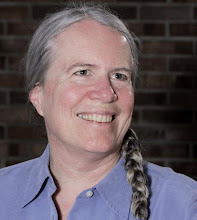I'm a 56 year old woman with a prescription of: R -725 sphere -275 cylinder, L -600 sphere -300 cylinder. That is, I am quite seriously nearsighted, though not in the extreme catagory, and have very significant astigmatism. My vision is too bad to be fully corrected by Lasik. I have never worn contacts because I couldn't bear the thought of touching my eye.
If I were
under 40 I would be waiting for the Visian Toric implantable contact lens to be
approved in the U.S. Implantable contact lenses are lower risk than the surgery
I am scheduled for, and should give the same quality of correction. But they
aren't used over age 45 because of the risk of needing cataract surgery in
relatively few years.
The procedure I am having is called Clear Lens Exchange or Refractive Lens Exchange. It is exactly the same as cataract surgery with the implantation of a corrective lens, but in my case I am having it done even though I don't yet have any signs of cataracts. I will have a monofocal toric lens implanted, which will correct my distance vision but leave me needing reading glasses. Most people who have such a procedure get a lens that does both distance and close up, but they don't yet make a lens for people with significant astigmatism that corrects both. And I am not interested in waiting until one comes on the market because the multifocal lenses come at some compromise of sharpness of vision and clarity of night vision. I prize the sharpest possible vision more than not having to wear reading glasses. I am paying for this out of pocket--if I did have cataracts the insurance would pay for the surgery and simpler lenses. My total cost is around $3k per eye.
I had my pre-op appointment yesterday. The most serious risk in my situation is of retinal detachment--perhaps a 1% risk. That risk is greater for people who are nearsighted, particularly with a correction over 9, and for men and younger patients. The risk is less if the vitreous has already detached from the retina, but that is not the case for me. The doctor is at least confident that my retinas show no problems.
He said that 85% of their patients end up with half a diopter of normal, that is, they would have a prescription between 050 and -050. They did a lot of measuring of my eyes, which is very important to me because I really want that accurate correction. My eyes were different lengths so they did an ultrasound to confirm those measurements. It was hard to tolerate the ultrasound sensor on my eyeball even well numbed--I didn't realize that I tolerate the usual pressure measurement well only because it is so familiar. I am going to need that sedation for the procedure.
The two surgeries will be done 6 days apart, Dec. 22 and 28. In between I will have to use only one eye, as my glasses make things smaller in a way that the lenses will not, so even if I popped one lense out of my glasses it would be too hard for my eyes to work together.
Posts in this series (reverse chronological order):
Eye Surgery Follow-up
Brain Adjustment
Second Vision Correction Surgery
The Week Between Surgeries
Day after Surgery
First Surgery
Refractive Lens Exchange


No comments:
Post a Comment